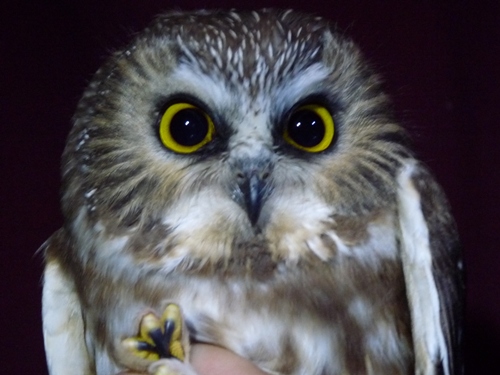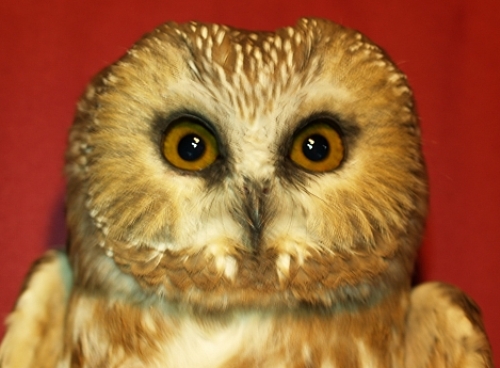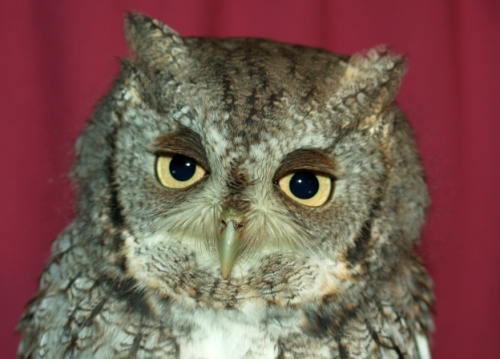|
McGILL BIRD OBSERVATORY |
||||||||||||||||||||||||||||||||||||||||||||||||||
McGill Bird Observatory experimented with Northern Saw-whet Owl monitoring in the fall of 2004, 2005, and 2007, operating between 8 and 11 nights each year, with modest totals ranging from 15 to 17 owls per season. This fall we decided to expand our effort, and also moved the nets to a different location at MBO, in and around a small grove of fir and spruce, rather than in the more shrubby deciduous woods where we had set the nets previously. The results were a great success, with a total of 80 owls captured this fall, including two Eastern Screech-owls and two Saw-whets banded in the United States in 2008. Details are below.
Banders-in-charge: Simon Duval, Marcel Gahbauer, Kristen Keyes
We began owling this fall on September 24, but since it was warm and we caught nothing, we waited until October 1 to try again. We banded our first two Saw-whets of the season that night, and on the next 9 nights we went out (between Oct 5 and 20) we had at least one owl every night. Activity peaked on October 12 (12 owls) and 13 (17 owls), with the latter night being especially noteworthy for us, since we banded as many owls in one night as we ever had in a full season previously! After October 20 we had a few more decent nights (6 on October 25, 4 on November 1, and 3 on November 11), but on the whole it was clearly past the peak of migration, with 6 nights of just one new owl, and 8 nights with none. In total, we operated for 28 nights this season, more than double any previous year. It helped that we had the work shared by three banders for the first time, but just as importantly the enthusiasm of our volunteers kept the program going, with special thanks to Bob Barnhurst, who helped out on 20 of our 28 nights! The extra effort no doubt was a big influence on our final numbers, since our total count of owls more than quadrupled over previous years, but our time invested also tripled. While the second half of the season was much slower in terms of volume, we had some of our most interesting birds during that time. Prior to this season we had only banded one Eastern Screech-owl at MBO, but we added two more to that total this year, both in early November (6 and 11). Also on November 11 we recaptured (for the third time) a Saw-whet that we banded on October 25, suggesting that perhaps it is considering remaining at MBO for the winter. Meanwhile we also had interesting encounters with three between-station migrants. On October 19 we recaptured a female Saw-whet banded in northern Michigan in July 2008, and then the next night we caught another previously banded Saw-whet, this one originally caught on migration in Virginia in November 2008. Just a couple of weeks after that, we received word that a Saw-whet we banded in mid-October had been recaptured 700 km to the south in Virginia, just 20 days later. Finally, we learned that another saw-whet we banded in mid-October was recaptured after one month at a banding station in New Paltz, New York (near Poughkeepsie).
We moved our nets this fall, using existing songbird net E1 as the anchor of a very loose oval around and through the small grove of firs and spruces in the middle of the old field. We kept track of all captures by net, and the results are quite interesting. Of the 76 new Saw-whet captures, 40 were in net O4, which bisects the grove of trees. Another 21 were in O1, which is parallel to O4 but along the north edge of the grove. The remaining four nets accounted for only 20% of all captures! So, perhaps it isn`t so much that the area we picked for owling this fall was that much better than in the past, just that we had a couple of particularly suitable net locations at the new site. Of note, while most owl banders use mist nets with a 60 mm mesh, we used our standard 30 mm songbird nets out of convenience, and still had great results (though of course it is difficult to know whether we might have caught even more with "owl nets"). Of the Saw-whets we banded this fall, 58 (76%) were hatch-year birds, another 7 (9%) were second-year, and the remainder were older, with a few showing at least three generations of feathers among the primaries and secondaries. There is normally a distinct female bias to saw-whet banding results, and our numbers are no different, with 55 females, 16 unknown sex, and 5 males. We spent relatively little time outside at night, except during net rounds, but did hear at least a few additional species. Long-eared, Barred, and Great Horned Owls were each heard on at least a few nights, with one Barred Owl seen perched on one of the net poles a single time. The only other species noted after dark this fall were Canada Goose and Wilson's Snipe. Of course a good variety of songbirds were active right up until dusk and occasionally a few were heard after dark, but we did not make a point of recording these. Other sounds in the night included the local coyotes and raccoons. Many other Saw-whet banding stations reported below average numbers this year, consistent with the cyclical nature of the population. The fact that we had such high numbers at MBO this year, compared to our previous totals, gives us great hope that we have found the right site for our nets, and that we'll be even more successful when the next population peak occurs. We are already looking forward to trying our luck again next year!
|



